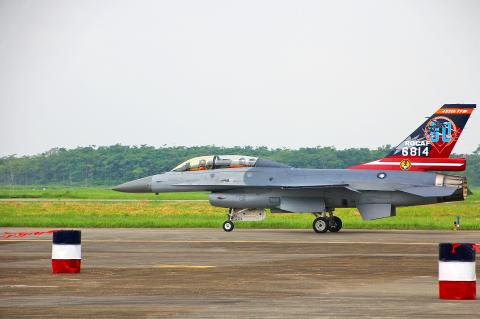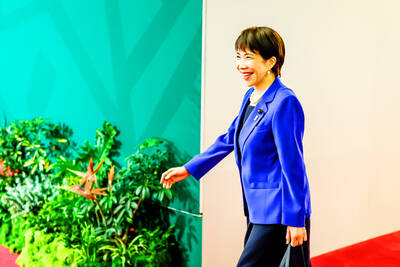The Ministry of National Defense is to increase the budget to upgrade the air force’s F-16 warplane fleet from NT$129.6 billion to NT$140.2 billion (US$4.21 billion to US$4.56 billion), a high-ranking defense official said yesterday.
Most of the budget increase aims to boost the number and types of air-to-air missiles the aircraft can carry, said the official, who declined to be named.
Better missiles are necessary to maintain parity between the upgraded F-16s and the Chinese People’s Liberation Army Air Force’s tactical fighters, the official said.

Photo: Lin Yi-chang, Taipei Times
Details of the missile portion of the budget would be disclosed to lawmakers on the Foreign Affairs and National Defense Committee when the Legislative Yuan reviews the national defense budget for fiscal 2019, the official said.
After the fatal crash of an F-16 piloted by major Wu Yen-ting (吳彥霆) during the annual Han Kuang military exercises in June, the military has decided to install the latest version of the automated ground collision avoidance system, which would also be covered by the additional funding, they said.
The system, which has been installed in the US Air Force’s F-16 fleet, enables the aircraft to pull up before crashing into the ground independently of pilot input, which is advantageous in instances where a pilot has been incapacitated or otherwise fails to take action to avoid controlled flight into terrain, they added.
The Republic of China Air Force’s standard-issue equipment for that purpose is the equivalent of the enhanced ground proximity warning system utilized by civilian airliners, the official said.
The proximity warning system is designed to emit an audio warning to the pilot when an aircraft is dangerously close to the ground, but it is not capable of taking action independently of the pilot, they said.
The US government has agreed to supply the armaments and equipment identified in the budget, while an earlier scheme for F-16V performance improvement packages — which is to be completed by 2023 — is to be followed as planned, the official said.

LIMITS: While China increases military pressure on Taiwan and expands its use of cognitive warfare, it is unwilling to target tech supply chains, the report said US and Taiwan military officials have warned that the Chinese People’s Liberation Army (PLA) could implement a blockade within “a matter of hours” and need only “minimal conversion time” prior to an attack on Taiwan, a report released on Tuesday by the US Senate’s China Economic and Security Review Commission said. “While there is no indication that China is planning an imminent attack, the United States and its allies and partners can no longer assume that a Taiwan contingency is a distant possibility for which they would have ample time to prepare,” it said. The commission made the comments in its annual

DETERMINATION: Beijing’s actions toward Tokyo have drawn international attention, but would likely bolster regional coordination and defense networks, the report said Japanese Prime Minister Sanae Takaichi’s administration is likely to prioritize security reforms and deterrence in the face of recent “hybrid” threats from China, the National Security Bureau (NSB) said. The bureau made the assessment in a written report to the Legislative Yuan ahead of an oral report and questions-and-answers session at the legislature’s Foreign Affairs and National Defense Committee tomorrow. The key points of Japan’s security reforms would be to reinforce security cooperation with the US, including enhancing defense deployment in the first island chain, pushing forward the integrated command and operations of the Japan Self-Defense Forces and US Forces Japan, as

IN THE NATIONAL INTEREST: Deputy Minister of Foreign Affairs Francois Wu said the strengthening of military facilities would help to maintain security in the Taiwan Strait Japanese Minister of Defense Shinjiro Koizumi, visiting a military base close to Taiwan, said plans to deploy missiles to the post would move forward as tensions smolder between Tokyo and Beijing. “The deployment can help lower the chance of an armed attack on our country,” Koizumi told reporters on Sunday as he wrapped up his first trip to the base on the southern Japanese island of Yonaguni. “The view that it will heighten regional tensions is not accurate.” Former Japanese minister of defense Gen Nakatani in January said that Tokyo wanted to base Type 03 Chu-SAM missiles on Yonaguni, but little progress

NO CHANGES: A Japanese spokesperson said that Tokyo remains consistent and open for dialogue, while Beijing has canceled diplomatic engagements A Japanese official blasted China’s claims that Japanese Prime Minister Sanae Takaichi has altered Japan’s position on a Taiwan crisis as “entirely baseless,” calling for more dialogue to stop ties between Asia’s top economies from spiraling. China vowed to take resolute self-defense against Japan if it “dared to intervene militarily in the Taiwan Strait” in a letter delivered Friday to the UN. “I’m aware of this letter,” said Maki Kobayashi, a senior Japanese government spokeswoman. “The claim our country has altered its position is entirely baseless,” she said on the sidelines of the G20 summit in Johannesburg on Saturday. The Chinese Ministry